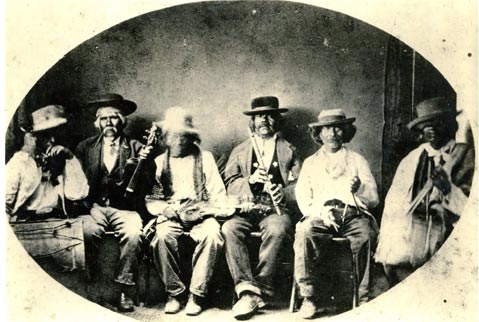Mission Music
Music Was Used by the Padres to Communicate with the Indigenous Peoples

Music played an important role in the relationship between the Chumash and the Franciscan missionaries of the South Coast. A key in the liturgy and ceremonies of Roman Catholicism, music was used by the padres to communicate with the indigenous peoples and to enhance their proselytizing campaign. Acculturation of the Chumash into European ways and beliefs accelerated as the natives formed choirs and instrumental groups under the watchful eyes of the padres.
Spanish explorers traveling through the South Coast took note of the musicality of the Chumash. The latter used a variety of instruments, including several types of flutes and whistles, as well as drums, rhythm sticks, and wooden clappers. One of the more unusual instruments was the bullroarer, a flat board that was swung around the head to make a low buzzing sound. Less common were single-stringed bowed instruments, one end of which was held in the mouth then plucked or tapped to produce notes.
The padres began introducing the Chumash to the music of the church by selecting boys around the age of nine whom they felt were particularly intelligent to train as singers and instrumentalists. Often taught to read and write, as well, these trainees could serve as conduits between the missionaries and the Chumash neophyte community. For the most part, the Chumash were drawn to the music of the Spanish newcomers.
For the first few years after the founding of Mission Santa Barbara in 1786, singing was performed by the congregation rather than any formal choir or musical group. The construction of the mission infrastructure necessarily had to come first. Hymns were sung in unison or in a call-and-response arrangement. Music was a part of everyday life at the mission, beginning with morning mass and including grace sung at meals. The neophytes had their work songs for use during their labors, and music played a part in celebrations and festive occasions. One padre wrote of nightly dances that took place in the mission courtyard.
Formal choirs accompanied by instrumental groups came later. The latter played a mix of strings, woodwinds, brass, and percussion. An 1834 inventory listed flutes, clarinets, trumpets, bass viols, drums, violins, triangles, and lutes in the instrumental collection at Mission Santa Barbara. There were even uniforms for the neophyte band members. Some instruments were imported, while others were made on-site. Usually only flutes and strings were utilized in church. The other instruments were used by orchestras, sometimes of 30 pieces or more, which played for a variety of occasions, including the weddings of colonists. Some groups traveled; bands from missions San Fernando and Santa Inés played at the rededication of Mission Santa Barbara in 1820.
Some neophyte musicians became celebrities. A Chumash named Antero was famed for his wonderful tenor voice and his skill on the bass viol. Two neophyte vocalists from Mission Santa Inés, one a bass, the other a contralto, also enjoyed widespread fame.
The Chumash choirs learned a wide range of liturgical selections. Musical notation was often color-coded so that three or four lines of music could be written on a single page. For example, a three-part mass employed yellow, red, and black notes for the three voices. Although most of the music came from Spain and Mexico, some was written in Alta California. Narciso Durán, who was at Mission Santa Barbara from 1833 until his death in 1846, is credited with composing two masses and several hymns.
Music was a key factor in developing relationships between the Chumash and the European colonists. It became a common language between the two groups that the padres found could be used as a tool to convert the natives to Catholicism and to draw them into the mission system.



